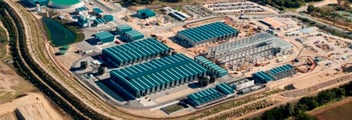Water Corporation CEO Sue Murphy reflects on 10 years at the top
After 10 years at the top, Water Corporation CEO Sue Murphy is passing the baton at the close of 2018. Here, Murphy reflects on her time in the water sector and the magnitude of change that utilities are capable of.
 Sue Murphy.
Sue Murphy.
Jim Gill, who was the CEO of the Water Corporation at the time, approached me in 2004 when the utility was about to start serious work on its first big desalination plant. The climate in Western Australia had changed dramatically. We were getting a fraction of the run-off into our dams we used to get, and the Water Corporation was looking at major capital upgrades to deal with climate change.
I’m an engineer and had spent the first 25 years of my career in construction, doing marine, oil, gas, minerals and infrastructure projects. I joined the Water Corporation in 2004 to run the Capital Program, and was appointed CEO a few years later when Jim Gill retired.
Top job
Working for Water Corporation in this capacity has been amazing. The water industry is the ultimate enabler. I don’t think there’s a single person in Western Australia who isn’t influenced by what we do. It really is an all-pervasive business.
The joy is that we cover nearly all customers in the whole state for water, wastewater and drainage. We have the capacity to do really detailed planning and the high-level strategy needed to keep the state operating, which is an absolute luxury.
The challenge for us in south-west Western Australia is climate. The changes to our climate are just phenomenal. We used to receive about 350 billion litres of run-off into our dams, we now get about 30 billion litres of run-off most years. We’ve rebuilt the entire south-west water supply as a result of this change. We now have two big desalination plants providing half of Perth’s water, and we’re recycling wastewater and recharging it into aquifers.
Our customers use about a third of the water that they used before 2001, so we’ve changed everyone’s behaviour too; we’ve changed the value set, we’ve changed where the water comes from, we’ve introduced groundwater replenishment. It’s been 10 fabulous years of change. And overlaid with that, Western Australia’s had the biggest construction boom in its history. The mining boom in the north-west was absolutely massive.
While the south-west has climate issues, the north west saw phenomenal growth with towns and mining camps springing up in areas with virtually no water supply. It’s been an amazing ride to service all of this change.
Lessons learned
There are a couple of things I’ve learnt during my time as CEO at Water Corporation. The first is we’ve got to keep close to our customers. Our customers are much smarter than we give them credit for, they know what they want and we need to listen to them and work really closely with them to deliver the right sort of solutions for their life.
Secondly, safety has probably been one of the biggest drivers of my time. It’s an appalling thought that anyone would return from work as fit and healthy as when they went to work. Hurting our employees is unacceptable, but hurting the community is unacceptable too. My obsession with safety translates into making sure that the water we supply is always safe, making sure that our assets are always safe. If we do both of these things, we’re going to be cost-effective and we’re probably going to be doing things that are appreciated and wanted, which means that the value we offer is recognised.
What’s next
There’s tonnes of things I am excited about seeing continue after my retirement. As a water industry and a water utility, we’ve optimised our networks, reduced leakage, worked with our customers, built new sources; we’ve done all those things. The next change is how we can work with the city planners to develop the way the city evolves. It’s not just about building infrastructure; it’s about building our cities so that we can use the natural urban form. We’re starting to think about how we can develop our urban form to use the water we have to create more appropriate public spaces and more liveable cities.
First published in Current magazine October 2018.


